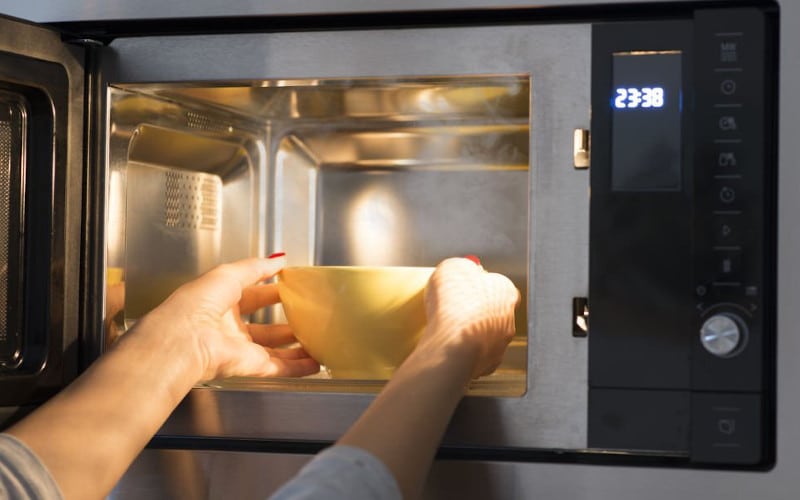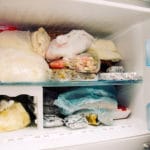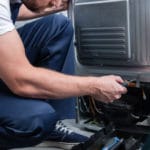If your Samsung microwave isn’t heating up food like it used to, don’t worry! We have the fix. In this blog post, we will discuss some common problems that can cause a Samsung microwave to stop heating and how to solve them.
We will also provide tips for keeping your Samsung microwave in good condition. So, read on for solutions to whether your Samsung microwave is not heating at all or just not heating evenly.
Faulty Diode
If your microwave goes out on you, there’s a chance it could be due to a known issue called “Diode Failure.” When the magnetron does not receive enough voltage, the diode burns out, resulting in damage.
Examine for any indicators of overheating. If you detect any indications such as blackening, bulging, or deformation of the component, it needs to be replaced.
Use a multimeter with a 9-volt battery linked if you’re unsure whether the diode is busted or need to check with an ohmmeter. Connect the multimeter’s red lead to one diode terminal and the black lead to the other terminal. If when they are reversed, there is no resistance (no continuity),
Defective Door Switch
On a microwave oven’s door, there are three or four switches. Each side of the door has a switch that closes when you shut it. This tells the microwave that the door is shut and begins to cook. The microwave will not function unless all of the door switches are working properly.
Remove any screws holding the microwave door’s outer coverings in place surrounding the switch. Place the tip of your multimeter into the slot that the switch occupies typically.
Make sure you’re testing each switch to tell which one isn’t working correctly. If your multimeter reads no continuity when you put it over any of the switches, that switch is defective and needs to be replaced.
Burnt Out Magnetron
You probably already know that a magnetron powers your microwave if you have one. If you’re not aware, a magnetron is a tube that uses a current of electrons to produce microwaves.
These microwaves then bounce around in the cooking chamber and cook your food. If your magnetron stops working, your microwave will cease to heat food.
Burnt Out High Voltage Capacitor
The capacitor is a crucial component of your microwave. When the transformer changes AC voltage to DC voltage for the magnetron tube, the capacitor stores energy. Thanks to this stored energy, the diode’s output can be increased when needed. This boosted voltage may double or even quadruple the quantity of power generated by your microwave.
The high-voltage capacitor in your microwave oven burns out when it is defective, causing the appliance to cease heating food. Use a multimeter with capacitance detection to check if the capacitor is faulty.
Failed High Voltage Transformer
The microwave transformer transfers energy from one circuit to another. It’s made of a unique electromagnetic material that can tolerate high voltages. If your microwave transformer breaks down, you’ll likely detect a burning odor.
That’s an indication the transformer has begun to fail, and you should get it changed right away.
Related: Samsung Refrigerator Temperature Blinking
Blown Thermal Fuse
A thermal fuse cuts off the power supply to a microwave to prevent overheating. If your thermal fuse is broken, you may be required to replace it with an original part. Examine the fuse for continuity using a multimeter if the microwave isn’t working.
Replace any faulty fuses with new ones if they don’t have continuity. Because the thermal fuse is a safety feature, you’ll want to ensure it’s in working order.
Tripped Thermoprotector
The thermostat is a sensor that keeps the microwave from overheating. If the sensor senses that the microwave is too hot, it cuts off power to the device, eliminating its ability to heat. This might happen if food blocks your microwave or if you don’t clean it regularly after use.
A multimeter is required for this procedure. Take one of the leads from your meter and place it on a screw that runs through the thermoprotector while the power is off at the breaker. Take the other lead and touch it to the middle prong of a regular US outlet.
If there is no indication, check to see whether your microwave is still getting power from the outlet. If your multimeter shows continuity, the thermoprotector is defective and must be replaced immediately.
Main Control Board
The main control board might be faulty. This is not very common, though. Control boards are frequently misdiagnosed—before replacing the control board, double-check all of the other potential culprits. If you’ve eliminated every other possibility and still can’t get your printer working, it’s time to replace the main control board.
Even after the microwave oven has been unplugged, the high voltage capacitor in the microwave oven can retain thousands of volts of electricity.
Because there is a risk of electric shock when replacing electronic components in a microwave, it is highly hazardous to do so. Only an authorized expert should replace the main control board.
Conclusion
If your Samsung microwave is not heating, there are several potential problems that you can troubleshoot. Check the burnt-out high voltage capacitor, failed high voltage transformer, blown thermal fuse, or tripped thermostat using a multimeter. If you find any faulty components, replace them immediately.
If all of these fail to fix the problem, then the main control board might be faulty, and you should call an authorized expert. Be extremely careful when handling the main control board, as it can retain thousands of volts of electricity even after the microwave has been unplugged.
Thanks for reading!
We hope this helps solve your problem. Good luck!






